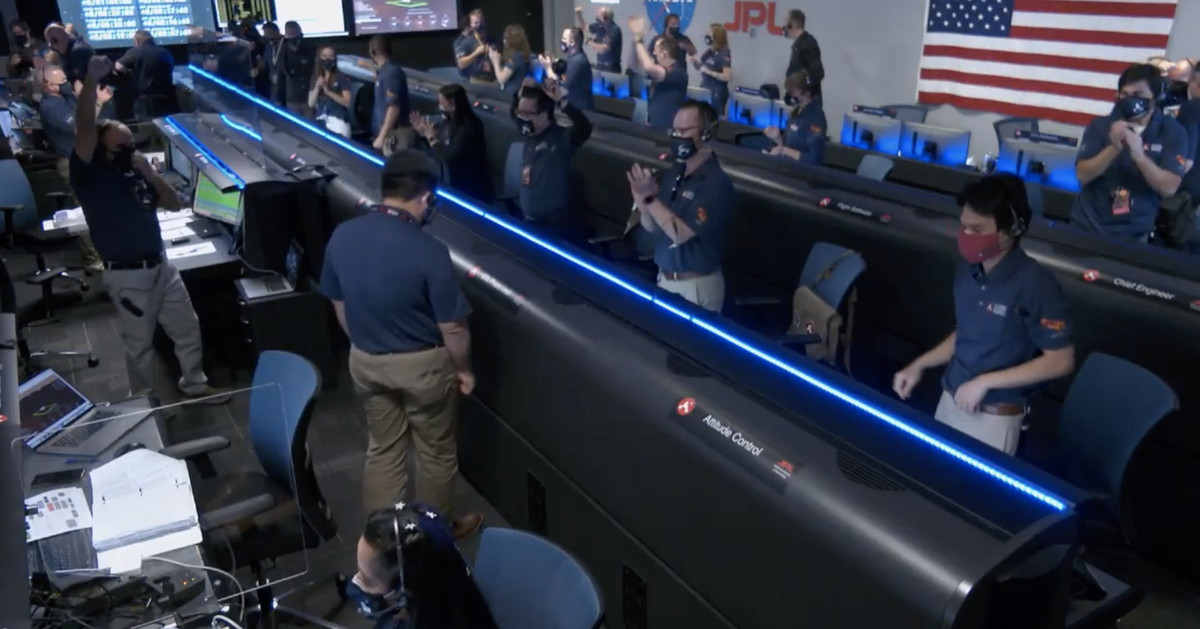NASA’s Perseverance rover successfully lands on Mars
Source: The Verge added 18th Feb 2021NASA’s Perseverance rover has successfully touched down on the surface of Mars after surviving a blazing seven-minute plunge through the Martian atmosphere. The rover’s clean landing sets the stage for a years-long journey to scour the Red Planet’s Jezero Crater for ancient signs of life.
Mission Control at NASA’s Jet Propulsion Laboratory in California confirmed Perseverance hit Mars’ atmosphere on time at 3:48PM ET at speeds of about 12,100 miles per hour, diving toward the surface in an infamously challenging sequence engineers call the “seven minutes of terror.” With an 11-minute comms delay between Mars and Earth, the spacecraft had to carry out its seven-minute plunge at all by itself with a wickedly complex set of pre-programmed instructions.
Enduring blazing heat, the rover was shielded by a protective shell and parachute to help slow itself down. A descent stage with six rocket thrusters fired as it neared the surface, slowing Perseverance to a much calmer 2 mph. Clutching the rover, the descent stage hovered 66 feet above the surface to execute a “skycrane” maneuver, where it gently lowered Perseverance on a set of cables the rest of the way to the surface.
Once the rover planted its six wheels on the surface, it snipped the skycrane cables, prompting the rocket-powered descent stage to move itself far away from Perseverance.
The SUV-sized rover has traveled 293 million miles since launching last summer in a slim window of time as Earth and Mars closely aligned in their orbits around the Sun. That alignment comes once every two years, and NASA launched its rover alongside China and UAE, whose Martian spacecraft reached the planet earlier this month.
Toward the end of its seven-month journey, Perseverance’s cruise stage carried out fewer orbital correction maneuvers than originally planned, in part due to an ultra-precise insertion on its Mars trajectory when it launched atop an Atlas V rocket from United Launch Alliance. “When we hit the bullseye, that means they had a ton more propellant” that NASA didn’t have to use on its journey to Mars, ULA CEO Tory Bruno told The Verge.
Developing…
brands: 11 Atlas It Million Planet SUN United WAS media: 'The Verge' keywords: NASA
Related posts
Notice: Undefined variable: all_related in /var/www/vhosts/rondea.com/httpdocs/wp-content/themes/rondea-2-0/single-article.php on line 88
Notice: Undefined variable: all_related in /var/www/vhosts/rondea.com/httpdocs/wp-content/themes/rondea-2-0/single-article.php on line 88
Related Products
Notice: Undefined variable: all_related in /var/www/vhosts/rondea.com/httpdocs/wp-content/themes/rondea-2-0/single-article.php on line 91
Warning: Invalid argument supplied for foreach() in /var/www/vhosts/rondea.com/httpdocs/wp-content/themes/rondea-2-0/single-article.php on line 91
